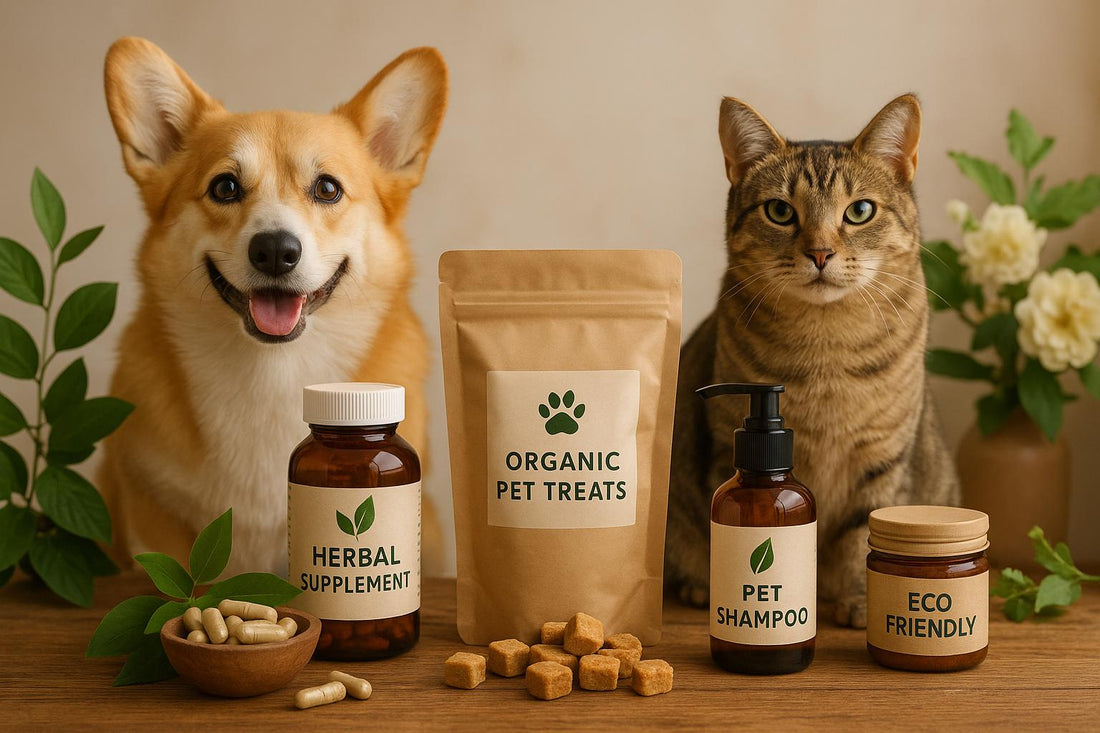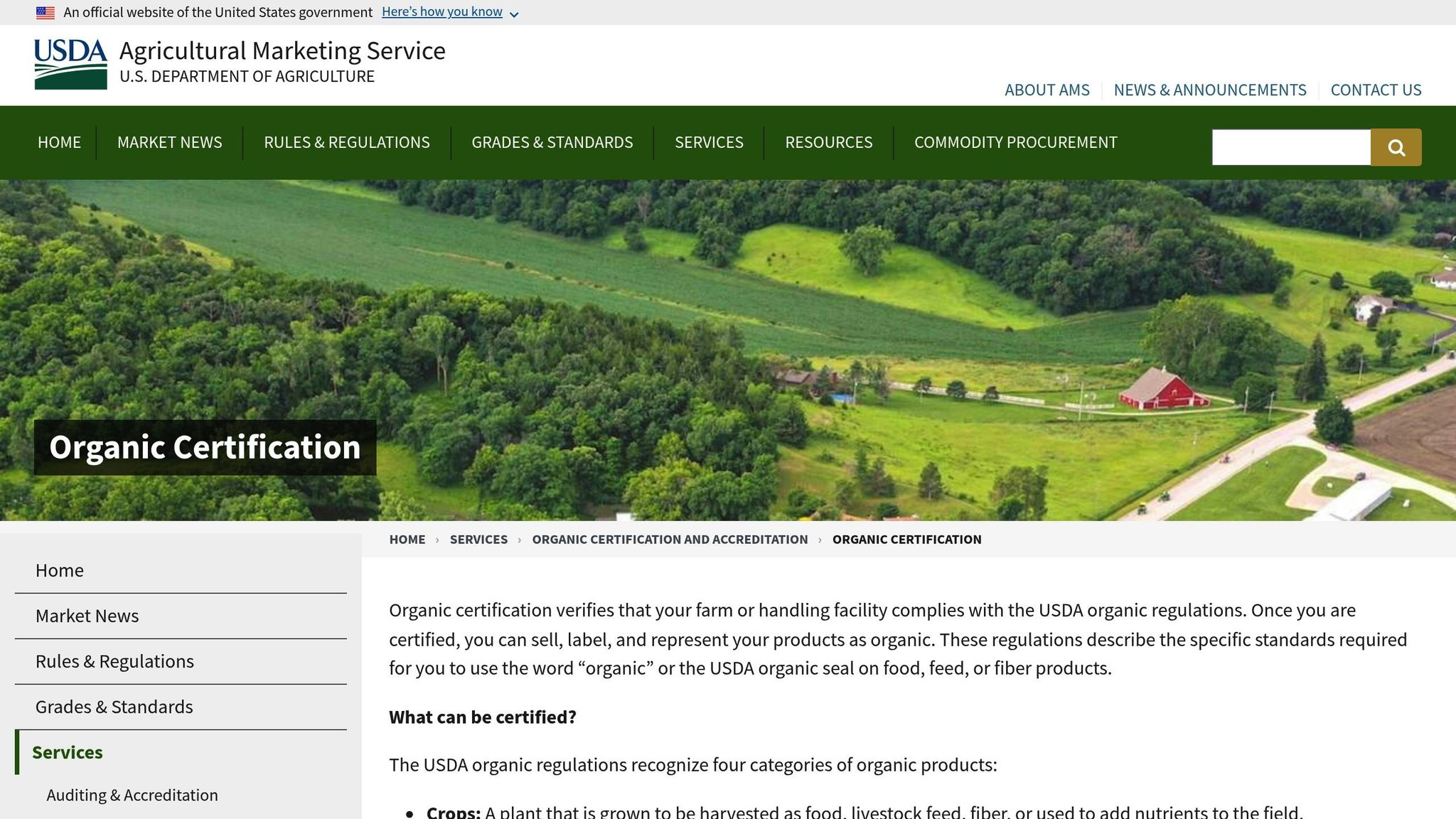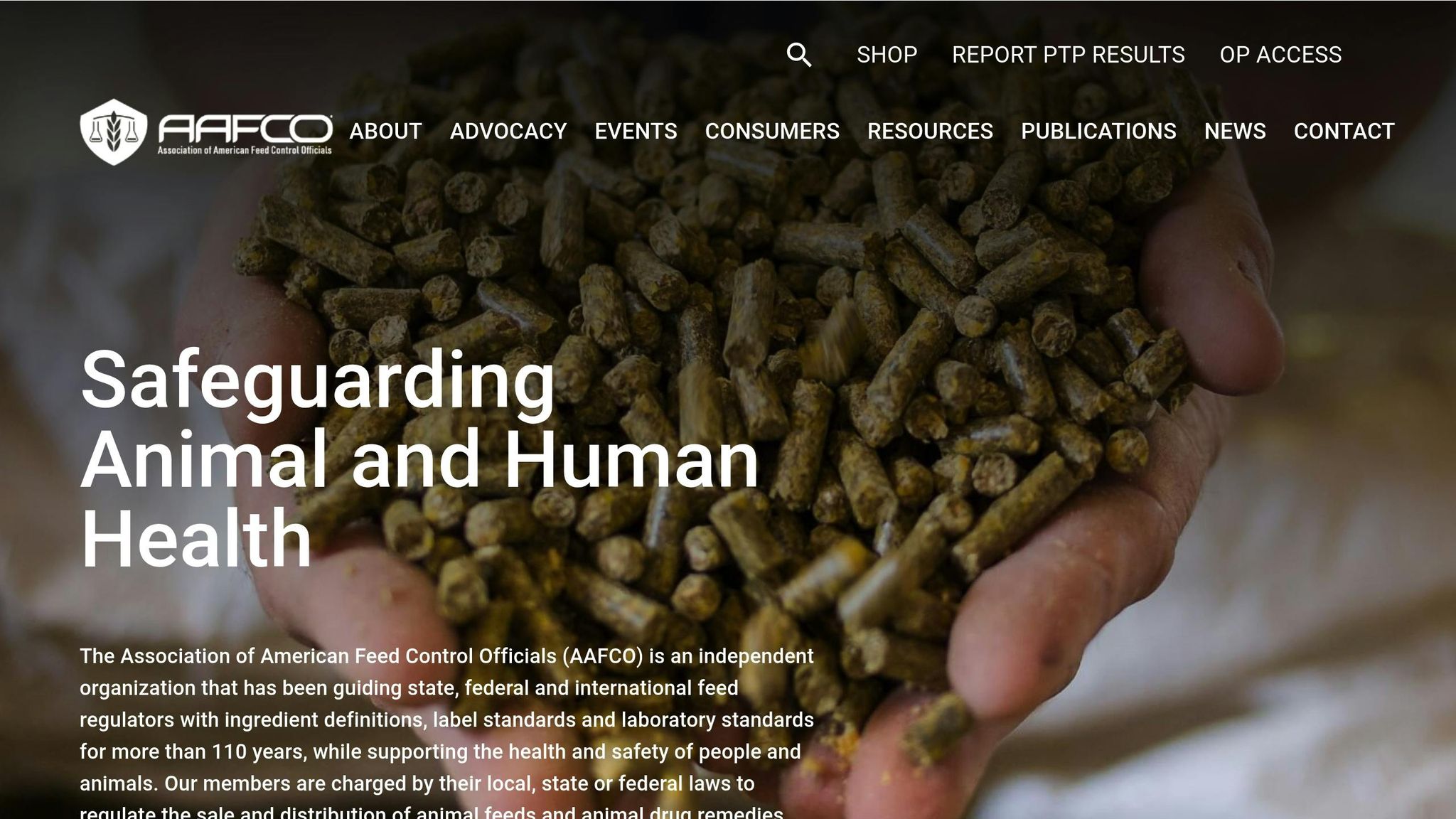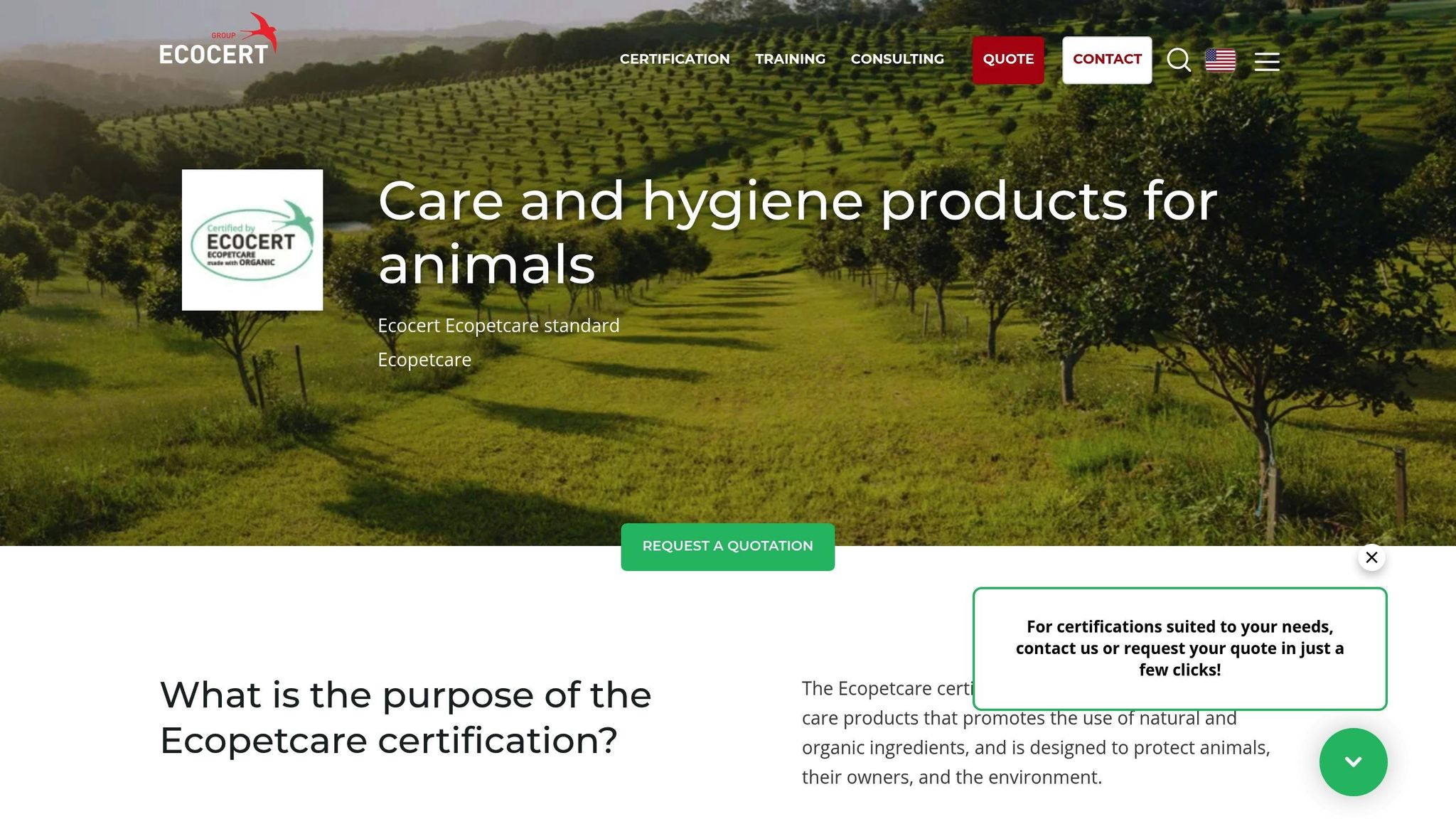
Top Certifications for Natural Pet Products
Share
When choosing natural pet products, certifications help ensure safety, quality, and ethical practices. They verify that products meet strict standards for ingredients, production methods, and animal welfare. Here’s a quick overview of key certifications:
- USDA Organic: Requires at least 95% organic ingredients, bans synthetic additives, and ensures sustainable farming practices.
- AAFCO Compliance: Focuses on nutritional adequacy, ensuring pet food meets balanced diet standards.
- Ecocert Ecopetcare: Guarantees natural or organic ingredients and excludes harmful chemicals.
- Global Animal Partnership (GAP): Prioritizes animal welfare with a tiered system, emphasizing humane farming practices.
- OEKO-TEX: Ensures pet accessories like beds and toys are free from harmful chemicals.
These certifications simplify your decision-making by providing transparency and assurance that products are safe for pets and responsibly produced.
Orivo Certification | Why it matters? | Natural Dog Company
1. USDA Organic Certification

The USDA Organic seal is a well-recognized marker of quality for natural pet products. Overseen by the United States Department of Agriculture, this program ensures that products meet strict organic standards established back in 2002.
Ingredient Standards: Organic, Natural, and Chemical-Free
To earn USDA Organic certification, at least 95% of a product's ingredients must come from certified organic sources. The remaining 5% can only include substances from an approved list, used when organic alternatives aren’t available. This means absolutely no synthetic pesticides, herbicides, fertilizers, or genetically modified organisms (GMOs) are allowed in the production process. For pet food, organic livestock must be raised on 100% organic feed and cannot be treated with antibiotics or growth hormones.
This meticulous control over ingredients helps eliminate synthetic additives, which can be a game-changer for pets with sensitive stomachs or allergies.
Pet treats and supplements with this certification undergo thorough testing to ensure they’re free from prohibited substances. Manufacturers must also keep detailed records of every ingredient and production method, ensuring full compliance with the certification’s high standards.
These ingredient rules also align with practices that promote sustainability in production.
Commitment to Environmental Responsibility
USDA Organic certification doesn’t just focus on the product itself - it also emphasizes sustainable production systems. Certified facilities are required to use practices that protect soil health, conserve water, and minimize pollution.
For pet food manufacturers, this means sourcing ingredients from farms that avoid synthetic chemicals and encourage biodiversity. Additionally, organic livestock must be raised in outdoor environments that allow them to exhibit natural behaviors, further supporting ethical and sustainable farming.
Ensuring Product Safety and Transparency
Beyond ingredient and environmental standards, USDA Organic certification guarantees product safety and transparency. Accredited third-party certifiers conduct mandatory annual inspections to confirm compliance with organic standards at every stage, from sourcing to packaging.
Manufacturers must maintain detailed records to create a traceability system. This ensures consumers can see exactly where their pet’s food or treats originated and allows for quick problem resolution if issues arise.
Clear labeling is another key requirement. Products labeled as "100% Organic" must consist entirely of organically produced ingredients. Those labeled simply as "Organic" must contain at least 95% organic ingredients by weight, excluding water and salt. This ensures that buyers can trust what’s written on the label.
2. AAFCO Compliance

While the USDA Organic label emphasizes organic sourcing and production methods, the Association of American Feed Control Officials (AAFCO) focuses on ensuring pet food is formulated properly and meets nutritional standards. AAFCO provides guidelines that serve as the foundation for state regulations, helping maintain consistency in how pet food is created and labeled across the United States.
Ingredient Standards (Organic, Natural, Chemical-Free)
AAFCO places a strong emphasis on transparency when it comes to ingredient sourcing and formulation. Their guidelines clearly define what qualifies as "natural" ingredients, requiring them to come from specific plant, animal, or mineral origins. This attention to ingredient integrity not only prevents misleading claims but also builds consumer confidence in natural pet food products. These standards ensure that safety and quality remain priorities throughout the production process.
Product Safety and Transparency
To meet AAFCO's standards, manufacturers must either conduct feeding trials or adhere to established nutrient profiles to confirm their products provide balanced nutrition for pets at various life stages. Additionally, clear labeling is a must - ingredients must be listed in descending order by weight. This straightforward approach helps pet owners make informed decisions by understanding exactly what’s in their pet's food.
In short, following AAFCO guidelines is a cornerstone of quality assurance in the pet food industry, ensuring both product safety and the trust of pet owners.
3. Ecocert Ecopetcare Certification

The Ecocert Ecopetcare certification sets a high bar for animal care products, ensuring they are made with natural and organic ingredients. Its goal is to safeguard not just animals and their owners but also the planet by enforcing strict standards that exclude harmful chemicals.
Ingredient Standards (Organic, Natural, Chemical-Free)
To meet Ecocert Ecopetcare standards, products must primarily consist of natural or organic ingredients. The certification recognizes two key categories of raw materials: organic-certified ingredients that align with COSMOS certification standards and natural raw materials that are COSMOS-approved. Depending on the product type, there are specific minimum percentages of organic ingredients required. Additionally, the certification strictly bans synthetic fragrances, colorants, parabens, phthalates, and other potentially harmful additives. This ensures that only safe, renewable, and environmentally friendly components make it into certified products.
sbb-itb-861ee2e
4. Global Animal Partnership (GAP) Certification
The Global Animal Partnership (GAP) Certification uses a tiered system - steps 1 through 5+ - to evaluate and improve animal welfare across the supply chain. Each step reflects progressively higher welfare standards for animals involved in product production. These standards work alongside other certifications to support the integrity of pet products.
Animal Welfare Focus
Animal welfare is the cornerstone of GAP certification. The program ensures animals in the production chain are given access to outdoor spaces and are raised in environments that allow them to express natural behaviors. For instance, Step 1 eliminates cages and crates, while higher levels mandate pasture access and specific space requirements per animal. For pet food manufacturers, this means sourcing ingredients from farms where animals are treated with care, allowed to move freely, socialize, and behave naturally.
The certification also bans the routine use of antibiotics and growth hormones in animals used for ingredient sourcing. This ensures that natural pet food ingredients remain free from residues, promoting safer and cleaner products for pets.
Environmental Responsibility
GAP-certified products emphasize farming methods that safeguard both animal welfare and the environment. Certified farms must adopt practices like rotational grazing to maintain healthy soil and productive pastures. This approach not only sustains the land but also supports animals' natural grazing habits.
Water quality is another critical focus. Farms must provide clean water for animals and implement waste management systems to prevent contamination of nearby water sources. These environmental measures contribute to producing cleaner and more sustainable ingredients for pet foods and treats.
Product Safety and Transparency
GAP certification demands full traceability from farm to finished product. Pet product manufacturers are required to document the origins of all animal-derived ingredients and confirm that every supplier meets the appropriate GAP step standards. This level of transparency gives pet owners confidence in the quality and ethical sourcing of the ingredients in their pets' food.
To maintain compliance, GAP-certified facilities undergo regular third-party audits - at least once a year. These inspections cover aspects like animal housing, feed quality, and veterinary care. The results of these audits are made available to the public, offering an extra layer of transparency and empowering pet owners to make informed choices when selecting products for their furry companions.
5. OEKO-TEX Certification for Pet Accessories

OEKO-TEX certification isn’t just for pet food - it also applies to pet accessories like collars, leashes, beds, and toys. This certification ensures that the textiles used in these products have been tested for harmful chemicals, providing an added layer of safety for your furry friends.
Under the OEKO-TEX Standard 100, materials such as dyes, threads, and fasteners are rigorously tested to ensure they don’t contain substances that could irritate your pet’s skin or trigger allergies.
Additionally, the OEKO-TEX MADE IN GREEN label goes a step further. It guarantees that the products are made under socially and environmentally responsible conditions, giving pet owners peace of mind about both safety and ethical manufacturing. Just like food certifications, OEKO-TEX reflects a commitment to keeping pet care free of harmful chemicals while promoting sustainability.
Certification Comparison Chart
This chart highlights the key differences between popular pet product certifications. Use it to quickly understand what each certification guarantees and how it applies to various products.
| Certification | What It Guarantees | Product Types Covered | Key Requirements | Seal Appearance |
|---|---|---|---|---|
| USDA Organic | At least 95% organic ingredients, free from synthetic pesticides and fertilizers | Pet food, treats, supplements | Annual inspections, detailed record-keeping, and certified organic sourcing | Green and white circular seal with "USDA ORGANIC" text |
| AAFCO Compliance | Ensures complete and balanced nutrition tailored to life stage requirements | Dog and cat food, treats | Nutritional adequacy testing, feeding trials, or meeting nutrient profiles | Statement on packaging rather than a distinct seal |
| Ecocert Ecopetcare | Focuses on natural and organic ingredients with an emphasis on environmental responsibility | Pet food, treats, grooming products, accessories | High percentage of natural ingredients, sustainable packaging, and ethical sourcing | Blue and green circular logo with a leaf design |
| Global Animal Partnership (GAP) | Reflects higher animal welfare standards across the supply chain | Pet food containing animal proteins | Multi-step rating system with third-party audits and a focus on continuous improvement | Step-rated shield logo (e.g., Steps 1–5+) |
| OEKO-TEX Standard 100 | Verifies textiles in pet accessories are free from harmful chemicals | Collars, leashes, beds, toys, clothing | Extensive testing for harmful substances to ensure materials are safe for skin contact | "Confidence in Textiles" label with a test number |
Each certification addresses different aspects of pet safety and quality. If you're worried about chemical exposure, USDA Organic and OEKO-TEX certifications are great choices. For nutritional assurance, products meeting AAFCO compliance standards deliver balanced diets. Animal welfare supporters might prefer GAP-certified options, while eco-conscious pet owners could look for items certified by Ecocert Ecopetcare.
Some brands combine certifications for added peace of mind. For example, premium natural pet food brands often pair USDA Organic with AAFCO compliance to ensure both ingredient purity and balanced nutrition.
Conclusion
Opting for certified natural pet products is a step toward prioritizing your pet's well-being. The certifications we've discussed, from USDA Organic for organic ingredient standards to AAFCO compliance for balanced nutrition, play a vital role in simplifying decisions for your furry companions.
These certification seals are more than just labels - they're assurances of safety and transparency. For instance, OEKO-TEX certification ensures that textile products like beds or toys are free from harmful chemicals, while Ecocert Ecopetcare confirms that manufacturing processes are environmentally responsible. Meanwhile, Global Animal Partnership certification ensures animal welfare is upheld throughout the supply chain.
The rising demand for certified natural products highlights a shift in awareness among pet owners, driven by concerns over the potential risks of conventional products. Safer, chemical-free alternatives are becoming more accessible across various pet care categories. Take, for example, the CatanDog's Medal, which offers up to 5 years of flea and tick protection using bio-resonance technology - no chemicals, batteries, or harmful substances involved. It’s a compelling example of innovative solutions aligned with these safety principles.
Ultimately, certifications act as a trusted benchmark, ensuring products meet stringent health, nutrition, and environmental standards. They’re not just marketing tools - they’re quality assurance systems backed by rigorous testing and regular oversight. Whether you’re choosing food, grooming supplies, or accessories, these certifications give you the confidence to make informed decisions that support your pet’s health and happiness.
FAQs
How can I choose the right certification for my pet's needs?
When it comes to picking the right certification for pet products, it all boils down to your pet’s health, safety, and the product’s intended use. For example, if you’re shopping for pet food, check for certifications like AAFCO approval, which ensures the food meets nutritional standards. On the other hand, for items like toys or supplements, certifications from organizations such as CPS or ASTM can provide reassurance about safety and durability.
It’s also important to consider your pet’s unique needs. If your furry friend has allergies or sensitivities, look for labels that highlight features like being chemical-free or hypoallergenic. And when in doubt, your veterinarian is a great resource - they can guide you toward the certifications that will best support your pet’s health and happiness.
What’s the difference between USDA Organic and Ecocert Ecopetcare certifications for pet products?
USDA Organic is a certification backed by the U.S. government, ensuring that pet products meet strict agricultural standards and contain at least 95% organic ingredients. This certification promotes natural farming methods and is widely recognized within the United States.
In contrast, Ecocert Ecopetcare is an international certification specifically designed for animal care products. It highlights the use of natural and organic ingredients while focusing on environmental sustainability and product safety.
The main difference? USDA Organic is a U.S.-based, government-regulated certification, whereas Ecocert Ecopetcare operates globally and caters to eco-friendly pet care on an international scale.
What does Global Animal Partnership (GAP) certification guarantee for animal welfare in pet food production?
The Global Animal Partnership (GAP) certification sets the bar high for animal welfare in pet food production, emphasizing humane treatment at every stage of an animal's life. This means animals are raised in environments that encourage natural behaviors, have access to pastures, and are fed vegetarian diets without any animal by-products.
GAP also takes a close look at how animals are treated during transport and processing, ensuring ethical practices are followed from start to finish. Its multi-level system, verified through third-party audits, outlines progressively stricter welfare standards, with the upper tiers demanding the most thorough care and attention to animal well-being.
